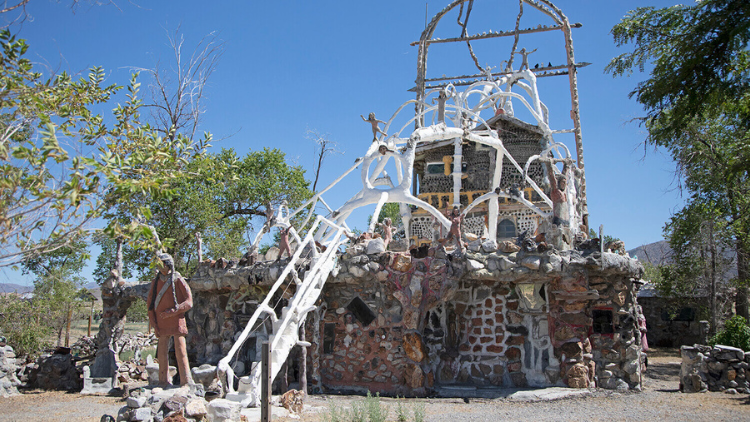Thunder Mountain Monument – Nevada’s Forgotten Folk Fortress
Just off I-80 in the middle of the Nevada desert stands a crumbling castle made from broken glass, car hoods, dolls’ heads, railroad ties, rebar, and rebar dreams. It’s not a joke, not a gimmick, and definitely not a tourist trap.
This is Thunder Mountain Monument, a shrine to pain, prophecy, and protest—crafted by a man who called himself Chief Thunder Mountain.
Where It Is
Location: Imlay, Nevada
Address: Off Interstate 80, Exit 145 (look for a small sign that says “Thunder Mountain”)
Hours: Open to walk around during daylight. No staff, no fee. Donations welcome.
It’s about halfway between Lovelock and Winnemucca, in the literal middle of nowhere.
Who Was Chief Thunder Mountain?
Born Frank Van Zant in Oklahoma, he was a World War II vet, a trained preacher, and a Choctaw man who eventually rejected his Anglo name and upbringing. In the late 1960s, he renamed himself Chief Rolling Mountain Thunder, claiming spiritual visions that told him to build a monument to Native suffering and survival.
He found a patch of high desert near the Humboldt River and started building. For 20 years.
He used salvaged junk, local stone, old cars, cement, and scrap metal—anything he could find. He built massive concrete sculptures, multi-story towers, and shrines honoring massacred tribes, ancient spirits, and persecuted people. He embedded warning messages in the walls—political, spiritual, and apocalyptic.
It was a sanctuary, an artwork, a fortress, and a scream.
What You’ll See
- A 3-story fortress-like house made from old trailers, windows, and car parts, sealed in concrete.
- Dozens of faces and totems carved into the stone and wood, some peaceful, others haunted.
- Dioramas and displays showing Native genocide, U.S. history, and spiritual journeys.
- Statues of prophets, chiefs, and animals—some broken, all watching.
- Embedded religious texts, bones, and trash, all placed with intent.
Much of it is in ruin now, from weather and time. But it adds to the atmosphere—like walking through the forgotten dreams of a dying god.
The Tragedy
In 1989, after years of struggle, vandalism, and government pressure, Chief Thunder Mountain died by suicide. His sons now protect the site, but much of the work remains in various stages of decay and restoration.
The house was listed on the National Register of Historic Places in 1992.
Why It Still Matters
Thunder Mountain Monument isn’t polished or packaged. It’s raw, emotional, and unapologetically strange. It’s outsider art in the truest sense—a place where trauma, identity, and resistance took physical form in concrete and junk.
If you’re driving across northern Nevada, pull off the highway. Walk slow. Listen.
You might not understand what you’re looking at, but you’ll feel it.



